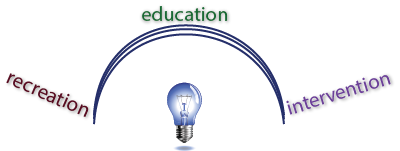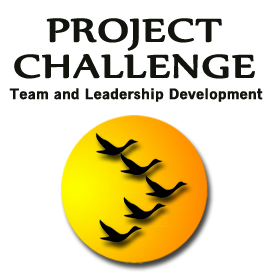Think of our services as spanning an arch, a continuum of program design which, depending on which part of the arch you focus on, will have unique custom content.

1. RECREATION; the beginning of this arch is made up of programs where the focus is on fun, getting to know each other; addressing the key theme/message of your meeting playfully; building trust through building relationships, laughter, and happy memorable experiences. The activity could be:
- Survivor style games
- Building a Blimp
- Playing Samba
- Creating 5 minute stage plays/musicals
- Over a dozen others…
Regardless of the activity selected, the objective would be to play and have fun! The importance of this part of the spectrum cannot be overstated; the research on the importance of play, building “things” together, rubbing elbows, and simply enjoying one’s company all suggests that groups that regularly do this enjoy a higher capacity for problem-solving, better cross-boundary relationships and higher “Positivity” in the workplace. At the end of a Recreation program, participants can say without reservations: “We had Fun together”.
2. EDUCATION; this part of the spectrum addresses LEARNING specific theory, and learning about specific Competencies and Mental Models. These could be:
- Emotional Intelligence in the Workplace
- Recognizing and Leveraging Individual Strengths
- Innovation, Enablers and Barriers
- Building and Managing a Healthy Team
- Management versus Leadership
- Advocacy and Inquiry in Conversation and Making good Decisions
To be sure, these programs are also fun, but the key focus is education. At the end of a program designed with these objectives, participants will be able to say: “We Learned something”.
3. INTERVENTION; when a team or group has adopted behaviors that are unproductive or downright destructive; when they are lacking behavioral Norms and need critical behavior change, then a design focused toward Intervention would be proper. These are rarely done alone but are rather multi-disciplinary involving:
- Experiential Exercises
- Appropriate Self-Disclosure between Team members revealing areas which need to be individually and collectively addressed.
- Coaching
- Skillful use of Personality Inventory instruments such as Myers Briggs.
- Thorough understanding of Cognitive Models such as “The Ladder of Inference”.
- Several follow-up sessions.
As you can see Intervention is not a one-shot deal. It takes time. Our company has collaborated in programs such as these over the years and we pride ourselves in our ability to be a seamless collaborative element in a more comprehensive design. We have worked with coaches, consultants, and universities on many instances, each time improving our ability to complement the Intervention with the use of experience-based training exercises. At the end of a series of programs of this nature, participants should be able to say: “We are Changing for the Better”.
The spectrum presented here is never that clear cut though. There are many times when a recreational program will be imbued with some additional learning; or times when even in a serious intervention a group will need the levity and laughter that a short recreational activity can offer. We hope though, that the above model will help you better understand and articulate your own goals and objectives for your groups or teams so that we might be better at designing a program that “hits it out of the park”.
IF YOU WANT TO GO FAST, GO ALONE. IF YOU WANT TO GO FAR, GO TOGETHER.

